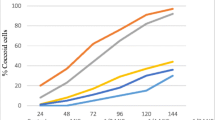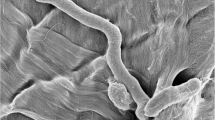Abstract
Helicobacter pylori exists in two morphologic forms: spiral shaped and coccoid. The nonculturable coccoid forms were believed to be the morphologic manifestations of cell death for a long time. However, recent studies indicate the viability of such forms. This form of H. pylori is now suspected to play a role in the transmission of the bacteria and is partly responsible for relapse of infection after antimicrobial treatment. Urease activity of H. pylori is an important maintenance factor. Determination of urease activity and possible mutations in the DNA sequences of coccoid bacteria will hence contribute to the understanding of pathogenesis of infections, which these forms might be responsible for. In this study, our aim was to analyze the urease activity and investigate the urease gene sequences of coccoid H. pylori forms induced by different factors with respect to the spiral form. For this purpose, the urease activities of H. pylori NCTC 11637 standard strain and two clinical isolates were examined before and after transformation of the cells to coccoid forms by different methods such as exposure to amoxicillin, aerobiosis, cold starvation, and aging. The effects of these conditions on the urease gene were examined by the amplification of 411-bp ureA gene and 115-bp ureB gene regions by PCR technique and sequencing of the ureA gene. The urease activities of coccoid cells were found to be lower than those of the spiral form. ureA and ureB gene regions were amplified in all coccoid cells by PCR. Inducing the change to coccoid form by different methods was found to have no effect on the nucleotide sequence of the ureA gene. These results show that the urease gene region of coccoid H. pylori is highly protected under various mild environmental conditions.


Similar content being viewed by others
References
Azevedo NF, Almedia C, Cerqueira L, et al. (2007) Coccoid form of Helicobacter pylori as a morphological manifestation of cell adaptation to the environment. Appl Environ Microbiol 73(10):3423–3427
Azevedo NF, Pacheco AP, Keevil CW, et al. (2006) Adhesion of water stressed Helicobacter pylori to abiotic surfaces. J Appl Microbiol 101:718–724
Azevedo NF, Pacheco AP, Vieria MJ, et al. (2004) Nutrient schock and incubation atmosphere influence recovery of culturable Helicobacter pylori from water. Appl Environ Microbiol 70:490–493
Benaissa M, Babin P, Quellard N, et al. (1996) Changes in Helicobacter pylori ultrastructure and antigens during conversion from the bacillary to the coccoid form. Infect Immun 64(6):2331–2335
Berry V, Jennings K, Woodnutt G (1995) Bactericidal and morphological effects of amoxicillin on Helicobacter pylori. Antimicrob Agents Chemother 39:1859–1861
Brenciaglia MI, Fornara AM, Scaltrito MM, et al. (2000) Helicobacter pylori: cultivability and antibiotic susceptibility of coccoid forms. Int J Antimicrob Agents 13(4):237–241
Campbell S, Fraser A, Holliss B, et al. (1997) Evidence for ethnic tropism of Helicobacter pylori. Infect Immun 65(9):3708–3712
Cellini L, Robuffo I, Di Campli E, et al. (1998) Recovery of Helicobacter pylori ATCC43504 from a viable but not culturable state: Regrowth or resuscitation? APMIS 106(5):571–579
Chan WY, Hui PK, Leung KM, et al. (1994) Coccoid forms of Helicobacter pylori in the human stomach. Am J Clin Pathol 102(4):503–507
Chaput C, Acobichon C, Cayet N, et al. (2006) Role of AmiA in the morphological transition of Helicobacter pylori and in immune escape. PLoS Pathogens 2:844–852
Chuang MH, Wu MS, Lin JT, et al. (2005) Proteomic analysis of proteins expressed by Helicobacter pylori under oxidative stress. Proteomics 5:3895–3901
Cole SP, Cirillo D, Kagnoff MF, et al. (1997) Coccoid and spiral Helicobacter pylori differ in their abilities to adhere to gastric epithelial cells and induce interleukin-8 secretion. Infect Immun 65(2):843–846
Deloney CR, Schiller NL (1999) Competition of various beta-lactam antibiotics for the major penicillin-binding proteins of Helicobacter pylori: antibacterial activity and effects on bacterial morphology. Antimicrob Agents Chemother 43(11):2702–2709
Eaton KA, Catrenich CE, Makin KM, et al. (1995) Virulence of coccoid and bacillary forms of Helicobacter pylori in gnotobiotic piglets. J Infect Dis 171(2):459–462
Gribbon LT, Barer MR (1995) Oxidative metabolism in nonculturable Helicobacter pylori and Vibrio vulnificus cells studied by substrate-enhanced tetrazolium reduction and digital image processing. Appl Environ Microbiol 61(9):3379–3384
Kusters JG, Gerrits MM, Van Strijp JAG, et al. (1997) Coccoid forms of Helicobacter pylori are the morphologic manifestation of cell death. Infect Immun 65:3672–3679
Lee A, Buck F (1996) Vaccination and mucosal responses to Helicobacter pylori infection. Aliment Pharmacol Ther 10(Suppl 1):129–138
Mobley HL, Island MD, Hausinger RP (1995) Molecular biology of microbial ureases. Microbiol Rev 59(3):451–480
Nagai S, Mimuro H, Yamada B, et al. (2007) Role of Peyer’s patches in the induction of Helicobacter pylori-induced gastritis. Proc Natl Acad Sci USA 104(21):8971–8976
Nillsson HO, Blom J, Al-Soud WA, et al. (2002) Effect of cold starvation, acid stress and nutrients on metabolic activity of Helicobacter pylori. Appl Environ Microbiol 68(1):11–19
Otteman KM, Lowenthal AC (2002) Helicobacter pylori uses motility for initial colonization and to attain robust infection. Infect Immun 70(4):1984–1990
Owen RJ, Slater ER, Xerry J, et al. (1998) Development of a scheme for genotyping Helicobacter pylori based on allelic variation in urease subunit genes. J Clin Microbiol 36(12):3710–3712
Park AM, Li Q, Nagata K, et al. (2004) Oxygen tension regulates reactive oxygen generation and mutation of Helicobacter pylori. Free Radic Biol Med 36(9):1126–1133
Perez-Perez GI, Rothenbacher D, Brenner H (2004) Epidemiology of Helicobacter pylori infection. Helicobacter 9(Suppl 1):1–6
Rabelo-Goncalves EM, Nishimura NF, Zeitune JM (2002) Acute inflammatory response in the stomach of BALB/c mice challenged with coccoidal Helicobacter pylori. Mem Inst Oswaldo Cruz 97(8):1201–1206
Scott DR, Marcus EA, Weeks DL, et al. (2000) Expression of the Helicobacter pylori ureI gene is required for acidic pH activation of cytoplasmic urease. Infect Immun 68(2):470–477
Segal ED, Falkow S, Tompkins LS (1996) Helicobacter pylori attachment to gastric cells induces cytoskeletal rearrangements and tyrosine phosphorylation of host cell proteins. Proc Natl Acad Sci USA 93(3):1259–1264
Shahamat M, Alavi M, Watts JE, et al. (2004) Development of two PCR-based techniques for detecting helical and coccoid forms of Helicobacter pylori. J Clin Microbiol 42(8):3613–3619
Shahamat M, Alem N, Asalkhou M, et al. (2006) IgM antibody response to antigens prepared from vegetative and coccoid forms of Helicobacter pylori. Exp Mol Pathol 81:171–175
She FF, Lin JY, Liu JY, et al. (2003) Virulence of water-induced coccoid Helicobacter pylori and its experimental infection in mice. World J Gastroenterol 9(3):516–520
She FF, Su DH, Lin JY, et al. (2001) Virulence and potential pathogenicity of coccoid Helicobacter pylori induced by antibiotics. World J Gastroenterol 7(2):254–258
Sisto F, Brenciaglia MI, Scaltrito MM (2000) Helicobacter pylori: ureA, cagA and vacA expression during conversion to the coccoid form. Int J Antimic Agents 15:277–282
Sorberg M, Nilsson M, Hanberger H, et al. (1996) Morphologic conversion of Helicobacter pylori from bacillary to coccoid form. Eur J Clin Microbiol Infect Dis 15(3):216–219
Wang KX, Wang XF (2004) Cloning and sequencing of cagA gene fragment of Helicobacter pylori with coccoid form. World J Gastroenterol 10(23):3511–3513
Wang X, Sturegard E, Rupar R, et al. (1997) Infection of BALB/c A mice by spiral and coccoid forms of Helicobacter pylori. J Med Microbiol 46(8):657–663
Wang XF, Wang KX (2004) Cloning and expression of vacA gene fragment of Helicobacter pylori with coccoid form. J Chin Med Assoc 67(11):549–556
Acknowledgments
This study was supported by a grant from the Scientific and Technical Research Council of Turkey (TUBITAK; Project No. SBAG-HD068) and by Baskent University Medical Research Committee (Project No. DA-0528).
Author information
Authors and Affiliations
Corresponding author
Rights and permissions
About this article
Cite this article
Can, F., Karahan, C., Dolapci, I. et al. Urease Activity and Urea Gene Sequencing of Coccoid Forms of H. pylori Induced by Different Factors. Curr Microbiol 56, 150–155 (2008). https://doi.org/10.1007/s00284-007-9047-y
Received:
Accepted:
Published:
Issue Date:
DOI: https://doi.org/10.1007/s00284-007-9047-y




